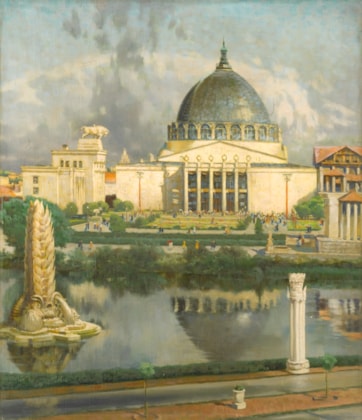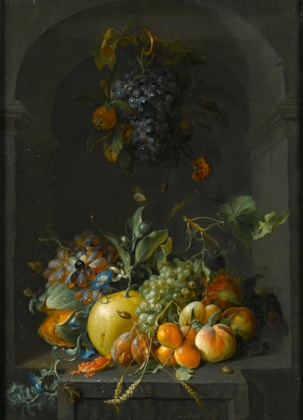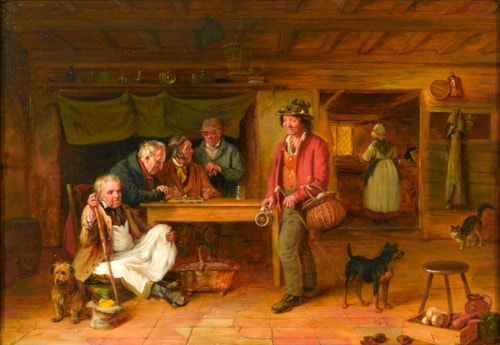elmich von Tweenhuysen II
(Amsterdam c. 1604 - Gdańsk 1673)
Portrait of a Bearded Cleric
oil on canvas
74 x 58.7 cm (29⅛ x 23⅛ in)
This intriguing half-portrait is a new addition to the small extant ouevre of Helmich van Tweenhuysen II. A bearded cleric of Eastern-European appearance looks directly out at the viewer with a penetrating gaze. He is dressed in a tall soft cap and dark robes, augmented by thick sash and a crucifix on a chain. Although his dress is relatively sober, the rich velvet of his cap, glinting colours of the chains around his neck and cap suggest that the sitter is a figure of wealth and importance.
Currently the sitter’s identity remains elusive. He appears in another very similar portrait by van Tweenhuysen in the Muzeum Narodowe in Wroclaw, Poland. In the Wroclaw portrait, the sitter turns in the opposite direction, and his right hand rests upon a book, but he is dressed in the identical restrained but luxurious costume. It has been suggested that the soft cap would indicate the sitter to be a member of the Orthodox Church,¹ although it must also be considered that such caps were often used as decorative accessories in portraits by artists working under the influence of Rembrandt (1606-1669). It does, however, seem likely that the sitter is cleric of some importance due to the fact that two portraits of him were commissioned from van Tweenhuysen.
Van Tweenhuysen was active in Gdańsk, and for a number of reasons the city was one of the centres of theological discussion in Europe during the seventeenth-century. Gdańsk and its neighbours had a reputation, not only for religious tolerance since the Warsaw Confederation of 1573, but also for academia,² and so was a natural place for Theologians to converge to discuss the merits of religious syncretism. Perhaps the most notable demonstration of this was the Colloquium Charitativum at Toruń in 1645. Although this particular meeting was between Roman Catholics, Lutherans and Calvinists, representatives of the Orthodox Church, the Socinians and the Greek Catholics were also actively involved in discussions throughout this period. It seem likely that the sitter in the present work is one of these representatives, and it is noteworthy that in the Wroclaw version he holds a book, perhaps a reference to his being a theologian.
Very little is known of van Tweenhuysen’s life and work. The Wroclaw painting is signed with a monogram ‘HvT’, and so the portrait was traditionally ascribed to the anonymous Monogrammist HVT.³ Lech Brusewicz first connected the Wroclaw work to van Tweenhuysen, in addition to two religious works.⁴ A similar portrait of a man wearing a similar fur hat and decorative chains (although without the pendant) has recently appeared on the European art market, and this work bears van Tweenhuysen’s monogram.⁵ The attribution of the present work to van Tweenhuysen has been made on the basis of the clear stylistic similarities between it and the two monogrammed portraits.
Van Tweenhuysen was from a prominent merchant family, who had originally come from Zwolle. His uncle was Lambert van Tweenhuysen who had settled in Amsterdam at the age of twenty five. He was one of the most significant traders of the period, with business links all over Europe, but perhaps most importantly with the Baltic harbours including Gdańsk. As a founder of the New Netherland Company, he was also a pioneering figure in exploring new trading ventures with Native Americans in the Dutch colony New Netherland. Lambert’s brother was Helmich van Tweenhuysen I who was also in Amsterdam by 1596, when he married Maria van Ceulen. Two of their sons, Arent and Helmich II were to become painters. Although archival records are slightly fragmentary, it is clear the family spent time in both Amsterdam and Zwolle, where Helmich I was burgomaster, during the first two decades of the seventeenth century.
Helmich II clearly spent a considerable portion of his life living and working in Gdańsk. It is notable that his brother Arent applied for citizenship of the city. Additionally two prints by Jeremias Falck (1610-1677), engraved after works by van Tweenhuysen, depict the famed astronomer Johannes Hevelius, as well as a self portrait. These serve as testament to van Tweenhuysen’s artistic standing in Gdańsk. However, the impact of Rembrandt’s work on van Tweenhuysen is overt, and so it seems that he must have been aware artistic developments in Amsterdam. This could have been due to familial ties to the city, but Brusewicz has hypothesised that the link may have be through the artist brothers Hendrick (c.1587-1661) and Rombout (c. 1583-1628) van Uylenburgh.6 From 1625 Hendrick lived in Amsterdam, and in the 1630s Rembrandt first moved into his house, before taking over his studio. Whilst Hendrick had moved to the Netherlands, Rombout had established a successful career in Krakow and Gdańsk, and presumably knew van Tweenhuysen. Both the van Uylenburgh travelled to and forth from Amsterdam to Gdańsk, and so it seems very plausible that van Tweenhuysen could keep abreast with Netherlandish artistic developments. In any case van Tweenhuysen’s work certainly made its way to Amsterdam. The only seventeenth century record of his work is in the 1699 inventory of the Dutch trader David d’Orville which lists ten paintings in his collection.
Whilst both the artist and the sitter of this remarkable portrait remain somewhat mysterious, the work of van Tweenhuysen is now being examined by scholars, having lain unrecognised for centuries. It is to be hoped that this continuing scholarship can shed more light on the circumstances surrounding the commissioning of the present portrait, as well as well as providing more details about van Tweenhuysen’s life and work.
¹ Steinborn, B., Catalogue of the Collection of Netherlandish Painting, Muzeum Narodowe we Wroclawiu (Wroclaw, 2006), p. 341.
² See Müller, M. G., ‘Science and Religion in Royal Prussia’ in Religious Confessions and the Sciences in the Sixteenth Century, ed. Helm, J. & Winkelmann, A. (Leiden, 2001) pp.37-43.
3 Sumowski, W. Gemälde der Rembrandt-Schüler (Landau/Pfalz 1983), vol. Vi, p. 4004, cat. no. 1389.
4 Brusewicz, L., ‘Zagadka tzw. Ecce Homo z kościola św. Piotra na Helu: studium recepcji sztuki Rembrandta w siedemnastowiecznej Rzeczypospolitej’ in Zabytkoznawstwo i Konserwatorstwo, XXV (Toruń, 1994), pp.59-83.
5 Salomon Lilian: Old Masters 2013, (Amsterdam 2013), cat no. 19.
6 Brusewicz, p. 80-81.
American Art Galleries, New York, 1903, no. 148.
with Dowdeswell and Dowdeswells, London, 1899;
with Eugene Fischhof, Paris;
his sale, New York, Chickering Hall, 9th March 1900, no. 102;
his sale, Paris, 16th May 1904, no. 24, (for Fr.1250);
Jos. Monchen et al sale, Amsterdam, Frederk Muller & Cie, 30th April 1907, no. 114 (for fl. 1000). (All the above as by Jan Lievens)
Hans Schneider, Jan Lievens: Sein Leben und Seine Werke (Bohn, 1932), p. 180, no. LXIX;
Salomon Lilian: Old Masters 2013, (Amsterdam 2013), p.76, fig. 1.
This intriguing half-portrait is a new addition to the small extant ouevre of Helmich van Tweenhuysen II. A bearded cleric of Eastern-European appearance looks directly out at the viewer with a penetrating gaze. He is dressed in a tall soft cap and dark robes, augmented by thick sash and a crucifix on a chain. Although his dress is relatively sober, the rich velvet of his cap, glinting colours of the chains around his neck and cap suggest that the sitter is a figure of wealth and importance.
Currently the sitter’s identity remains elusive. He appears in another very similar portrait by van Tweenhuysen in the Muzeum Narodowe in Wroclaw, Poland. In the Wroclaw portrait, the sitter turns in the opposite direction, and his right hand rests upon a book, but he is dressed in the identical restrained but luxurious costume. It has been suggested that the soft cap would indicate the sitter to be a member of the Orthodox Church,¹ although it must also be considered that such caps were often used as decorative accessories in portraits by artists working under the influence of Rembrandt (1606-1669). It does, however, seem likely that the sitter is cleric of some importance due to the fact that two portraits of him were commissioned from van Tweenhuysen.
Van Tweenhuysen was active in Gdańsk, and for a number of reasons the city was one of the centres of theological discussion in Europe during the seventeenth-century. Gdańsk and its neighbours had a reputation, not only for religious tolerance since the Warsaw Confederation of 1573, but also for academia,² and so was a natural place for Theologians to converge to discuss the merits of religious syncretism. Perhaps the most notable demonstration of this was the Colloquium Charitativum at Toruń in 1645. Although this particular meeting was between Roman Catholics, Lutherans and Calvinists, representatives of the Orthodox Church, the Socinians and the Greek Catholics were also actively involved in discussions throughout this period. It seem likely that the sitter in the present work is one of these representatives, and it is noteworthy that in the Wroclaw version he holds a book, perhaps a reference to his being a theologian.
Very little is known of van Tweenhuysen’s life and work. The Wroclaw painting is signed with a monogram ‘HvT’, and so the portrait was traditionally ascribed to the anonymous Monogrammist HVT.³ Lech Brusewicz first connected the Wroclaw work to van Tweenhuysen, in addition to two religious works.⁴ A similar portrait of a man wearing a similar fur hat and decorative chains (although without the pendant) has recently appeared on the European art market, and this work bears van Tweenhuysen’s monogram.⁵ The attribution of the present work to van Tweenhuysen has been made on the basis of the clear stylistic similarities between it and the two monogrammed portraits.
Van Tweenhuysen was from a prominent merchant family, who had originally come from Zwolle. His uncle was Lambert van Tweenhuysen who had settled in Amsterdam at the age of twenty five. He was one of the most significant traders of the period, with business links all over Europe, but perhaps most importantly with the Baltic harbours including Gdańsk. As a founder of the New Netherland Company, he was also a pioneering figure in exploring new trading ventures with Native Americans in the Dutch colony New Netherland. Lambert’s brother was Helmich van Tweenhuysen I who was also in Amsterdam by 1596, when he married Maria van Ceulen. Two of their sons, Arent and Helmich II were to become painters. Although archival records are slightly fragmentary, it is clear the family spent time in both Amsterdam and Zwolle, where Helmich I was burgomaster, during the first two decades of the seventeenth century.
Helmich II clearly spent a considerable portion of his life living and working in Gdańsk. It is notable that his brother Arent applied for citizenship of the city. Additionally two prints by Jeremias Falck (1610-1677), engraved after works by van Tweenhuysen, depict the famed astronomer Johannes Hevelius, as well as a self portrait. These serve as testament to van Tweenhuysen’s artistic standing in Gdańsk. However, the impact of Rembrandt’s work on van Tweenhuysen is overt, and so it seems that he must have been aware artistic developments in Amsterdam. This could have been due to familial ties to the city, but Brusewicz has hypothesised that the link may have be through the artist brothers Hendrick (c.1587-1661) and Rombout (c. 1583-1628) van Uylenburgh.6 From 1625 Hendrick lived in Amsterdam, and in the 1630s Rembrandt first moved into his house, before taking over his studio. Whilst Hendrick had moved to the Netherlands, Rombout had established a successful career in Krakow and Gdańsk, and presumably knew van Tweenhuysen. Both the van Uylenburgh travelled to and forth from Amsterdam to Gdańsk, and so it seems very plausible that van Tweenhuysen could keep abreast with Netherlandish artistic developments. In any case van Tweenhuysen’s work certainly made its way to Amsterdam. The only seventeenth century record of his work is in the 1699 inventory of the Dutch trader David d’Orville which lists ten paintings in his collection.
Whilst both the artist and the sitter of this remarkable portrait remain somewhat mysterious, the work of van Tweenhuysen is now being examined by scholars, having lain unrecognised for centuries. It is to be hoped that this continuing scholarship can shed more light on the circumstances surrounding the commissioning of the present portrait, as well as well as providing more details about van Tweenhuysen’s life and work.
¹ Steinborn, B., Catalogue of the Collection of Netherlandish Painting, Muzeum Narodowe we Wroclawiu (Wroclaw, 2006), p. 341.
² See Müller, M. G., ‘Science and Religion in Royal Prussia’ in Religious Confessions and the Sciences in the Sixteenth Century, ed. Helm, J. & Winkelmann, A. (Leiden, 2001) pp.37-43.
3 Sumowski, W. Gemälde der Rembrandt-Schüler (Landau/Pfalz 1983), vol. Vi, p. 4004, cat. no. 1389.
4 Brusewicz, L., ‘Zagadka tzw. Ecce Homo z kościola św. Piotra na Helu: studium recepcji sztuki Rembrandta w siedemnastowiecznej Rzeczypospolitej’ in Zabytkoznawstwo i Konserwatorstwo, XXV (Toruń, 1994), pp.59-83.
5 Salomon Lilian: Old Masters 2013, (Amsterdam 2013), cat no. 19.
6 Brusewicz, p. 80-81.
American Art Galleries, New York, 1903, no. 148.
with Dowdeswell and Dowdeswells, London, 1899;
with Eugene Fischhof, Paris;
his sale, New York, Chickering Hall, 9th March 1900, no. 102;
his sale, Paris, 16th May 1904, no. 24, (for Fr.1250);
Jos. Monchen et al sale, Amsterdam, Frederk Muller & Cie, 30th April 1907, no. 114 (for fl. 1000). (All the above as by Jan Lievens)
Hans Schneider, Jan Lievens: Sein Leben und Seine Werke (Bohn, 1932), p. 180, no. LXIX;
Salomon Lilian: Old Masters 2013, (Amsterdam 2013), p.76, fig. 1.





 contact
contact contact
contact +44 20 7313 8040
+44 20 7313 8040









